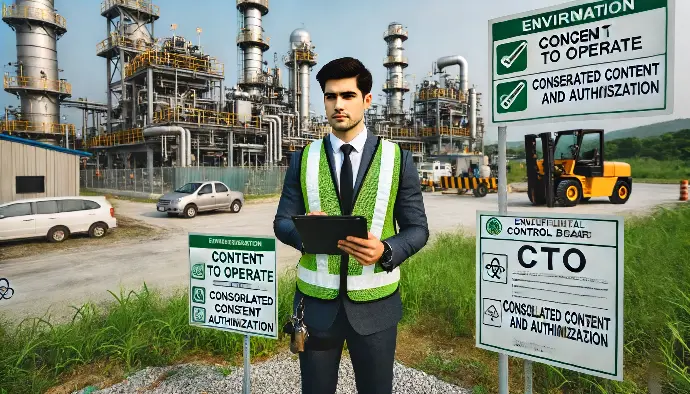Overview
Obtaining a Consent to Operate (CTO) or Consolidated Consent for Authorisation (CC&A) is a critical step for businesses and industries operating in India. These environmental licenses, mandated by the Pollution Control Boards, are essential to ensure that industrial activities comply with environmental regulations and do not harm the environment. The process of obtaining these consents involves multiple stages, including submission of applications, inspections, and approvals.
Environmental sustainability is a significant concern globally, and India is no exception. The Indian government has implemented stringent laws to ensure that industries operate within the framework of sustainable development. The CTO and CC&A are part of these regulatory measures aimed at controlling pollution and safeguarding natural resources.
These licenses are crucial for businesses as they validate that the company meets all the environmental norms. Without them, industries could face severe penalties, including shutdowns. Thus, understanding the process and requirements of obtaining a CTO or CC&A is essential for business continuity and compliance.
By adhering to these norms, businesses not only contribute to environmental conservation but also enhance their reputation and stakeholder trust. Obtaining these consents demonstrates a commitment to responsible operations and sustainability, which can be beneficial in attracting investors and customers who prioritize environmental responsibility.
In this guide, we will walk you through the process of obtaining a CTO or CC&A in India, covering various aspects such as the approval process, applicability, legal provisions, where to obtain, procedure, documents required, fees, authority, application mode, time limit, and frequently asked questions.
About Approval
The approval process for obtaining a Consent to Operate (CTO) or Consolidated Consent for Authorisation (CC&A) involves several steps designed to ensure compliance with environmental regulations. The approval is granted by the State Pollution Control Boards (SPCBs) or Pollution Control Committees (PCCs) for Union Territories.
The primary goal of the approval process is to assess whether the industry meets the necessary environmental standards. This includes evaluating the potential environmental impact of the industrial activities and ensuring that appropriate measures are in place to mitigate any adverse effects.
The process begins with the submission of a detailed application form, which includes information about the industrial operations, pollution control measures, and environmental management plans. Once the application is submitted, the pollution control board conducts a thorough review and may request additional information or clarifications.
An on-site inspection is usually part of the approval process, where officials from the pollution control board visit the facility to verify the information provided in the application. They assess the adequacy of the pollution control measures and ensure that the operations comply with the prescribed standards.
Upon satisfactory review and inspection, the pollution control board grants the consent, which is typically valid for a specified period. The consent must be renewed periodically, and compliance with the conditions outlined in the consent is mandatory throughout its validity period.
Applicability
The Consent to Operate (CTO) and Consolidated Consent for Authorisation (CC&A) are applicable to a wide range of industries operating in India. These include:
- Manufacturing Units: Industries involved in the production of goods, including chemical, pharmaceutical, textile, and food processing units.
- Construction Projects: Real estate developers, infrastructure projects, and construction companies.
- Service Industries: Hospitals, hotels, and other service-oriented businesses that generate waste or emissions.
- Mining and Quarrying: Companies involved in the extraction of minerals and natural resources.
- Energy Sector: Power plants, renewable energy projects, and other energy-related industries.
- Waste Management Facilities: Units involved in waste collection, recycling, and disposal.
These consents are mandatory for any industry that has the potential to impact the environment through emissions, effluents, or waste generation.
Legal Provisions
The legal framework governing the Consent to Operate (CTO) and Consolidated Consent for Authorisation (CC&A) in India is extensive. Here are the key legal provisions:
- Water (Prevention and Control of Pollution) Act, 1974: Mandates the need for obtaining consent for discharge of pollutants into water bodies.
- Air (Prevention and Control of Pollution) Act, 1981: Requires industries to obtain consent for emissions into the air.
- Environment (Protection) Act, 1986: Provides the overarching framework for environmental protection and includes provisions for obtaining environmental clearances.
- Hazardous and Other Wastes (Management and Transboundary Movement) Rules, 2016: Regulates the management of hazardous waste and requires authorization for handling such waste.
- Solid Waste Management Rules, 2016: Governs the management of solid waste and necessitates compliance with prescribed standards.
- E-Waste (Management) Rules, 2016: Requires authorization for the handling and disposal of electronic waste.
- Plastic Waste Management Rules, 2016: Mandates the proper management and disposal of plastic waste.
Where to Obtain
Industries can obtain the Consent to Operate (CTO) and Consolidated Consent for Authorisation (CC&A) from the respective State Pollution Control Boards (SPCBs) or Pollution Control Committees (PCCs) for Union Territories. The steps to obtain these consents are as follows:
- Identify the Relevant Authority: Each state and Union Territory has its pollution control board or committee.
- Visit the Official Website: Access the official website of the respective SPCB or PCC.
- Download the Application Forms: Forms are usually available in the 'Downloads' or 'Forms' section of the website.
- Submit the Application: Applications can be submitted online or offline, depending on the provisions of the respective pollution control board.
Procedure
The procedure for obtaining a Consent to Operate (CTO) or Consolidated Consent for Authorisation (CC&A) involves the following steps:
1. Prepare the Application:
- Gather necessary information about the industrial operations, including details of the production process, raw materials used, and waste generated.
- Prepare a comprehensive environmental management plan outlining the pollution control measures implemented.
2. Submit the Application:
- Visit the official website of the relevant State Pollution Control Board (SPCB) or Pollution Control Committee (PCC).
- Download the appropriate application form and fill it out with accurate details.
- Attach all required documents, including environmental management plans, site plans, and details of pollution control equipment.
3. Pay the Application Fee:
- Pay the prescribed application fee online or through a bank draft, as specified by the SPCB or PCC.
4. Site Inspection:
- Once the application is submitted, the SPCB or PCC may schedule an on-site inspection to verify the details provided in the application.
- Ensure that all pollution control measures are in place and functioning as described in the application.
5.Review and Approval:
- The SPCB or PCC reviews the application and inspection report.
- If additional information or clarification is required, respond promptly to avoid delays.
6. Grant of Consent:
- Upon satisfactory review, the SPCB or PCC grants the consent.
- The consent document will specify the conditions that must be adhered to during the operation of the industry.
7. Renewal:
- The consent is typically valid for a specified period and must be renewed before its expiry.
- Submit the renewal application with updated information and compliance reports.
Documents Required
When applying for a Consent to Operate (CTO) or Consolidated Consent for Authorisation (CC&A), the following documents are generally required:
- Application Form: Duly filled and signed application form.
- Project Report: Detailed project report including environmental management plans.
- Site Plan: Layout plan of the industrial facility.
- Pollution Control Measures: Details of pollution control equipment and measures implemented.
- Consent Fees: Proof of payment of the application fee.
- Previous Consent Orders: Copies of previous consents, if any.
- Environmental Clearance: Copy of environmental clearance certificate, if applicable.
- Company Registration: Certificate of incorporation or registration of the company.
- Compliance Reports: Previous compliance reports, if applicable.
- Affidavit: Affidavit stating compliance with environmental laws.
Fees
The fee for obtaining a Consent to Operate (CTO) or Consolidated Consent for Authorisation (CC&A) varies depending on the type and scale of the industry. It is determined by the respective State Pollution Control Board (SPCB) or Pollution Control Committee (PCC) and is typically based on the following factors:
- Industry Category: Fees may vary for different categories of industries, such as Red, Orange, and Green categories based on their pollution potential.
- Production Capacity: Higher production capacities may attract higher fees.
- Location: Fees may differ for industries located in different regions.
Authority
The authority responsible for granting the Consent to Operate (CTO) and Consolidated Consent for Authorisation (CC&A) is the State Pollution Control Board (SPCB) or the Pollution Control Committee (PCC) of the respective state or Union Territory. These bodies operate under the Ministry of Environment, Forest and Climate Change (MoEFCC) and are responsible for enforcing environmental regulations and standards.
Application Mode
The application for a Consent to Operate (CTO) or Consolidated Consent for Authorisation (CC&A) can be submitted either online or offline, depending on the provisions of the respective State Pollution Control Board (SPCB) or Pollution Control Committee (PCC). Most SPCBs and PCCs have online portals where applications can be submitted electronically for convenience and efficiency.
Time Limit
The time limit for obtaining a Consent to Operate (CTO) or Consolidated Consent for Authorisation (CC&A) typically ranges from 30 to 90 days, depending on the complexity of the application and the efficiency of the respective State Pollution Control Board (SPCB) or Pollution Control Committee (PCC).
FAQs
A Consent to Operate (CTO) is a mandatory environmental license
that industries must obtain to ensure their operations comply with
environmental regulations.
Industries involved in manufacturing, construction, services,
mining, energy, and waste management activities that generate emissions,
effluents, or waste.
The validity of the consent varies but is typically between one to
five years, depending on the industry category and state regulations.
Key documents include the application form, project report, site
plan, pollution control measures, consent fees, previous consent orders,
environmental clearance, company registration, compliance reports, and an
affidavit.
The fee varies based on industry category, production capacity,
and location, as determined by the respective State Pollution Control
Board (SPCB) or Pollution Control Committee (PCC).
You can complete the application process by submitting it online through the SPCB or PCC portal and seek assistance by visiting their office.
The process usually takes between 30 to 90 days, depending on the
complexity of the application and the efficiency of the review process.
Yes, an on-site inspection is typically conducted to verify the
information provided in the application and assess compliance with
environmental standards.
Yes, the consent must be renewed before its expiry by submitting a
renewal application with updated information and compliance reports.
Violations can result in penalties, including fines, suspension of operations, and legal action by the pollution control board.

